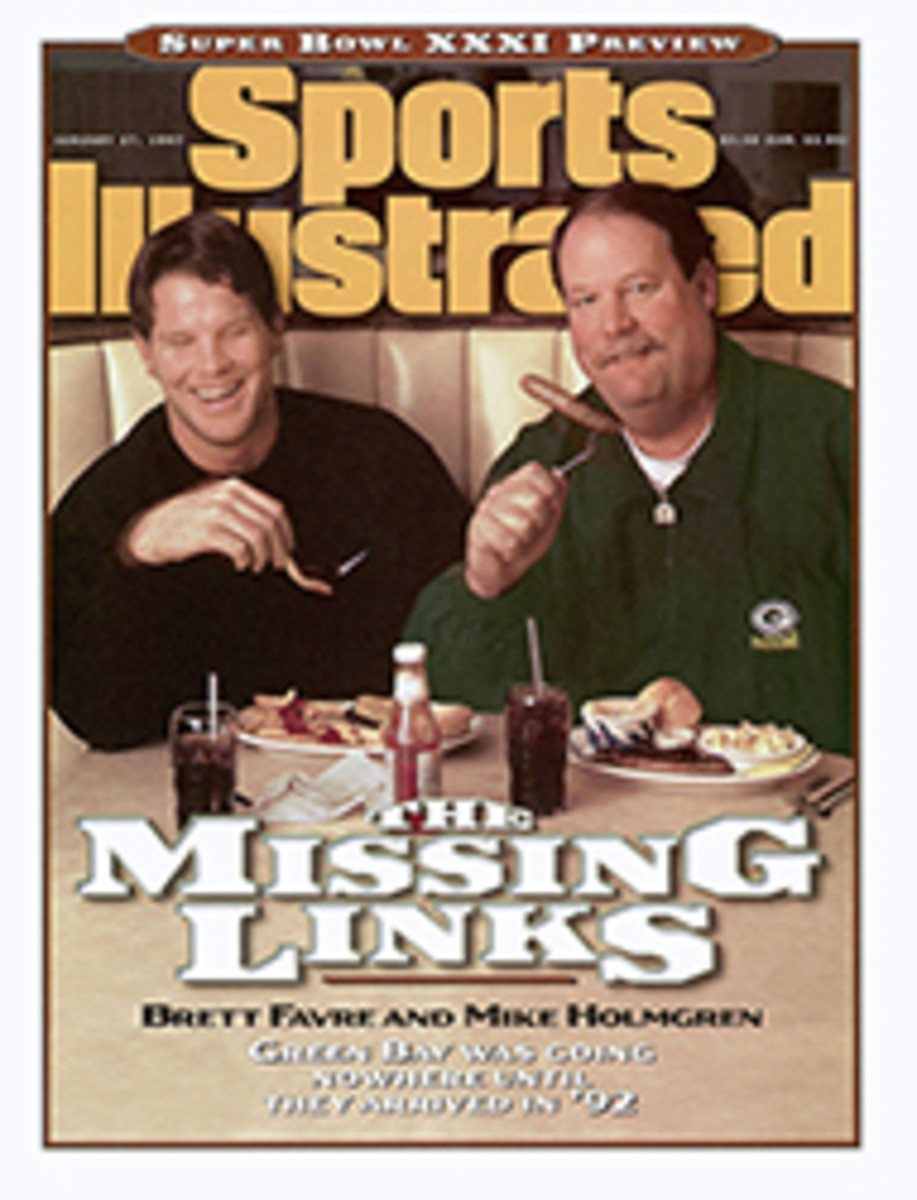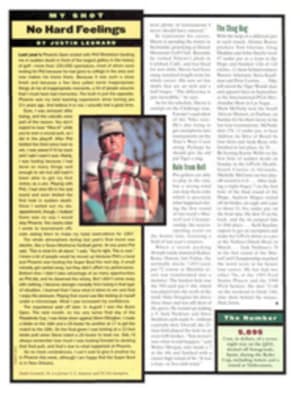
A FREUD FOR FIDO PROBLEM WITH YOUR HUNTING DOG? JACK CASSIDY IS THE MAN TO CALL
Hunting-dog owners who subscribe to Sam Goldwyn's axiom that
anyone who sees a psychiatrist ought to have his head examined,
should consult John (Jack) Cassidy of Middletown, N.Y. The
burly, 60-year-old former New York City fireman specializes in
problem pooches, such as retrievers who won't retrieve and
pointing dogs who won't point.
Many owners, influenced by research on canine behavior done in
the 1960s at the Jackson Laboratory in Maine, begin serious
field training when their puppies are only two or three months
old. The Jackson research suggested that the ideal time to
separate a puppy from its litter was at seven weeks, before
individuals start to dominate or be dominated by litter mates.
Also, contrary to accepted practice at the time, which held that
dogs should not be trained until they were almost a year old,
the Jackson studies suggested that training could begin at eight
weeks.
Cassidy believes that this is wrong and that serious training
should not start until a dog is at least six months old. He
says, "The most common problem I see--and it often starts by
trying to teach a dog to retrieve when he's too young--is the
dog that runs away from his owner. It begins when the dog
doesn't bring the dummy back a couple of times, so the owner
runs after him. The dog then will have a great time playing
'chase me now.' Then the dog starts running a little farther and
a little farther, and a little faster and a little faster, until
he's out there barking at the moon and the owner can't figure
out what went wrong. And that's when I get the dog."
Eight years ago, at the urging of Helen Ginnell, breeder of
Whygin Cork's Coot, twice winner of the National (Open)
Retriever Field Championship, I took Buster, my then 2-year-old
black Labrador retriever, to Cassidy. The dog had been great,
doing up to 60 retrieves a day, putting the dummy right into my
hands like a center giving the ball to the quarterback. His
sire, Trumarc's Zip Code, was one of the alltime top field-trial
retrievers in the country, and I had great plans for Buster.
Then, suddenly, he began these "chase me" antics, which gave me
fits. After four or five retrieves Buster would dance around, 20
feet from me, with the dummy in his mouth, daring me to try to
get him. I knew better than to chase him, so, feeling
frustrated, I would go back into the house. Two or three hours
later Buster would scratch to come inside. The next day, after
four or five retrieves, there would be more of the same.
After Buster spent two weeks with Cassidy, I got a call.
"Buster's cured," Cassidy said. He explained that I had
overtrained Buster, having him do too many retrieves a day.
After a while Buster had gotten bored doing the same thing over
and over, so he had started a game of his own. Cassidy
restricted Buster to only two or three retrieves a day, which
left the dog eager for more, and if he started to dance about,
well, a marble on his behind from a slingshot quickly brought
him around.
The Brooklyn-born Cassidy began training his own Labs for
hunting and field trials 33 years ago. At the time, trials were
largely the province of the Eastern gentry, and Cassidy
remembers that when he wrote "Bklyn" as his place of residence
on the membership form of the Westchester Retriever Club, the
club secretary smiled and pertly asked, "And just where is Bklyn?"
Had it not been for his day job, Cassidy would have started
working with dogs earlier and probably would have become a
trainer on the national field-trial retriever circuit, which
runs year-round. In 1986 he retired from the New York City Fire
Department after 27 years in a hook-and-ladder company as a
driver, tillerman, roof man, forceful-entry man and can man. The
can man carries a fire extinguisher. Cassidy says, "Most fires
are actually put out with a fire extinguisher, not by hose
companies."
To Cassidy, the No. 1 dog is the black Lab--usually the male,
who "will take much more punishment from the elements than the
female," he says. The black Lab is also "the easiest dog to
train, the hardest worker, a good family dog, a watchdog,"
Cassidy adds. However, now that the Lab is the most popular
breed in the country, Cassidy warns, "everybody and his brother
are breeding them, and in a few years you won't find a decent
one for hunting or a house pet except for one from field-trial
stock. Just the other day I was training a dog in a nearby park,
and a woman called out, 'Look, a Labrador that listens!'"
Cassidy ranks the yellow Lab second, followed by the chocolate
Lab. "The yellow is good, but when the chips come down, the
black will take two or three more steps in the right direction.
The chocolate is a good hunter, but most people who buy a
chocolate want to put a red ribbon on him and parade him in the
park. A good black Lab pup will cost maybe $500-$600, but any
chocolate pup now goes for around $600-$700, because chocolates
are fashionable."
Cassidy has informed opinions on other breeds as well. About the
Chesapeake Bay retriever, he says, "A rugged, tough, smart
individual. He's smarter than the Labrador, but he uses it
against himself. He has to be trained so that he thinks that
this is his way of doing things. Who should buy a Chesapeake?
Crazy people! The Chesapeake is just too macho. He becomes too
possessive with people. He believes that he owns the family, the
family doesn't own him, and he gets so possessive that he may
bite anybody who comes around."
Golden retrievers, on the other hand, are the opposite. "Goldens
have to be handled very gently. They're very soft, a special dog
for a special type of person," says Cassidy. "They work well for
women and don't take well to macho men. When they do get afraid,
they bite. They fight with more dogs, and they fight better than
most dogs. They're afraid of having another dog jumping them, so
they jump first. They're also very protective of their owners.
On land they're as good as any dog, and usually they're not good
in the water."
As for upland game dogs, Cassidy recommends two. "The English
pointer is for a young person in good shape. It has the most
style and the most drive," he says. "They do range, but you can
keep them within a distance over open terrain. You have to train
the dog to stay close.
"Around these parts [the wooded Northeast] the Brittany spaniel
is probably the best for upland game. They're smaller dogs, they
tend to stay close, but since they're bred for field trials,
some of them can really range."
English setters and springer spaniels also rate high with the
trainer: "The setter is very similar to the Brittany. Very
gentle and takes a lot of soft handling. And the springer is a
great dog. The field dogs are small, short-legged, brown and
white, spotted." Some nonfield springers are biters afflicted
with what is called springer rage.
There are some breeds of which Cassidy is no fan. "I've had some
German shorthair pointers that were real good, and others, about
50 percent, that were totally useless. I have more failures with
German shorthairs than any other breed. The failures are
overeager or they have no drive."
And although Cassidy looks back fondly on his days as a fireman,
he doesn't miss the firehouse Dalmatians. He says, "They were
nasty, horrible dogs."
TWO COLOR PHOTOS: PHOTOGRAPHS BY ROBIN SCHWARTZ Cassidy, who also breeds Labs (below), retrains recalcitrant hunting dogs by limiting them to only a few retrieves each day. [John (Jack) Cassidy training dog; three Labrador retriever puppies]
COLOR PHOTO: PHOTOGRAPHS BY ROBIN SCHWARTZ After a 27-year career as a New York City firefighter, Cassidy turned full time to canine training. [John (Jack) Cassidy with dog]

